
Ultima Markets App
Trade Anytime, Anywhere
Important Information
This website is managed by Ultima Markets’ international entities, and it’s important to emphasise that they are not subject to regulation by the FCA in the UK. Therefore, you must understand that you will not have the FCA’s protection when investing through this website – for example:
- You will not be guaranteed Negative Balance Protection
- You will not be protected by FCA’s leverage restrictions
- You will not have the right to settle disputes via the Financial Ombudsman Service (FOS)
- You will not be protected by Financial Services Compensation Scheme (FSCS)
- Any monies deposited will not be afforded the protection required under the FCA Client Assets Sourcebook. The level of protection for your funds will be determined by the regulations of the relevant local regulator.
Note: Ultima Markets is currently developing a dedicated website for UK clients and expects to onboard UK clients under FCA regulations in 2026.
If you would like to proceed and visit this website, you acknowledge and confirm the following:
- 1.The website is owned by Ultima Markets’ international entities and not by Ultima Markets UK Ltd, which is regulated by the FCA.
- 2.Ultima Markets Limited, or any of the Ultima Markets international entities, are neither based in the UK nor licensed by the FCA.
- 3.You are accessing the website at your own initiative and have not been solicited by Ultima Markets Limited in any way.
- 4.Investing through this website does not grant you the protections provided by the FCA.
- 5.Should you choose to invest through this website or with any of the international Ultima Markets entities, you will be subject to the rules and regulations of the relevant international regulatory authorities, not the FCA.
Ultima Markets wants to make it clear that we are duly licensed and authorised to offer the services and financial derivative products listed on our website. Individuals accessing this website and registering a trading account do so entirely of their own volition and without prior solicitation.
By confirming your decision to proceed with entering the website, you hereby affirm that this decision was solely initiated by you, and no solicitation has been made by any Ultima Markets entity.
I confirm my intention to proceed and enter this website Please direct me to the website operated by Ultima Markets , regulated by the FCA in the United KingdomScalp trading is a fast-paced, high-frequency strategy employed by traders aiming to make small, quick profits from minor price movements within a short time frame. This trading method is designed to capitalize on market inefficiencies that last only for a brief moment, making it one of the most active and demanding strategies in the trading world.
What Is Scalp Trading?
Scalp trading, often referred to as “scalping,” is a short-term trading strategy where traders look to make small profits on small price movements within minutes or even seconds. The goal is not to catch big moves but to accumulate many small wins throughout the day. Typically, scalpers enter and exit trades rapidly, capitalizing on slight price fluctuations. Given the frequency and volume of trades, scalping requires both precision and a solid risk management strategy.
Unlike traditional investing strategies where traders hold positions for days, weeks, or months, scalp traders aim to close positions within minutes, making it an intense strategy that demands complete focus and discipline.
Key Characteristics of Scalp Trading:
- High Frequency: Scalpers often make dozens, if not hundreds, of trades within a single day.
- Quick Execution: Trades are opened and closed rapidly to capture small price movements.
- Risk Management: Scalping involves stringent stop-loss and take-profit levels due to the volatility of the strategy.

Scalp Trading vs Day Trading: What’s the Difference?
Although both scalp trading and day trading fall under the category of short-term trading, they have some distinct differences in terms of trading style, time frames, and profit targets.
Time Horizon
- Scalp Trading: Scalpers typically hold positions for seconds to minutes. The strategy involves frequent entries and exits, capitalizing on small movements.
- Day Trading: Day traders hold positions for several hours or even the entire day, aiming to profit from larger price movements. Trades are usually closed by the end of the trading day.
Trading Frequency
- Scalp Trading: Scalpers execute high-frequency trades, often entering and exiting positions multiple times within a short span.
- Day Trading: Day traders typically make fewer trades in a day compared to scalpers but may still execute multiple trades based on their strategy.
Profit Per Trade
- Scalp Trading: The profit per trade is small, often measured in pips or points. Scalpers rely on volume to generate significant overall returns.
- Day Trading: Profits per trade tend to be larger due to the longer duration of trades, but they come with greater risk and time commitment.
Risk Exposure
- Scalp Trading: Because of the quick exits, scalpers limit their exposure to risk. However, the cumulative risk over many trades can still add up.
- Day Trading: Day traders may hold positions longer, which exposes them to more significant risk during market fluctuations.
Understanding these differences is crucial for choosing the right strategy based on your trading style, goals, and risk tolerance.
How to Scalp Trade
Scalp trading is an art that requires a combination of skill, speed, and precision. Below, we will dive deep into the strategies used by successful scalpers to gain an edge in the market.
Moving Average Crossover Strategy
The moving average crossover is one of the most popular scalp trading strategies. It involves using two moving averages: a shorter-period moving average (e.g., 5-period or 10-period) and a longer-period moving average (e.g., 20-period or 50-period). When the shorter-term moving average crosses above the longer-term moving average, it signals a buying opportunity. Conversely, when the shorter-term moving average crosses below the longer-term moving average, it indicates a selling opportunity.
How It Works:
- Buy Signal: When the short-term moving average crosses above the long-term moving average, indicating upward momentum.
- Sell Signal: When the short-term moving average crosses below the long-term moving average, signaling a potential downturn.
Support and Resistance Scalping
Support and resistance levels are foundational concepts in technical analysis, used by scalpers to predict where the price might reverse or bounce. Scalpers look for market retracements near these levels to execute their trades.
How It Works:
- Support: A level where the price tends to bounce higher as demand increases.
- Resistance: A level where the price tends to reverse downward due to selling pressure.
Scalpers aim to buy at support and sell at resistance, taking advantage of price retracements within a trend. This strategy requires a keen eye on chart patterns and quick decision-making.
Bid-Ask Spread Exploitation
The bid-ask spread is the difference between the price a buyer is willing to pay and the price a seller is willing to accept. Scalpers exploit this small price difference to generate profits.
How It Works:
Scalpers aim to buy at the bid price (the price at which buyers are willing to purchase) and sell at the ask price (the price at which sellers are willing to sell). By entering and exiting trades swiftly, scalpers can profit from small price changes that occur in the bid-ask spread.
Breakout Scalping
Breakout scalping is a strategy where traders look for price movements that break above resistance or below support levels. These breakouts typically occur after periods of consolidation, where price moves in a tight range before making a decisive move.
How It Works:
- Breakout Entry: When the price breaks above resistance or below support, it signals a potential surge in price.
- Exit Strategy: Scalpers exit quickly after the price shows momentum in the breakout direction.
The key to success in breakout scalping is anticipating when a breakout will occur and acting swiftly before the momentum fades.

Best Indicators for Scalp Trading
The success of scalp trading often hinges on the tools and indicators used. Here are some of the best indicators that can help scalp traders identify potential trade opportunities:
RSI (Relative Strength Index)
The RSI measures the magnitude of recent price changes to evaluate overbought or oversold conditions. Scalpers use it to identify entry points when the market is overbought or oversold.
Bollinger Bands
Bollinger Bands consist of a moving average and two standard deviations, which form a channel around the price action. When the price touches the upper or lower band, it could indicate an overbought or oversold condition, respectively.
MACD (Moving Average Convergence Divergence)
The MACD is a trend-following momentum indicator that shows the relationship between two moving averages. It’s used by scalpers to confirm trend reversals or continuation signals.
Stochastic Oscillator
This momentum indicator compares the current price to the price range over a given period. It helps identify overbought or oversold conditions, which are key entry and exit points for scalpers.
Scalping in Forex and Cryptocurrency Markets
Scalping can be successfully applied in both the forex and cryptocurrency markets, although each market presents unique challenges and opportunities.
Scalping in Forex
The forex market is highly liquid, and currencies like EUR/USD, GBP/USD, and USD/JPY offer tight spreads and consistent volatility—perfect for scalp trading. Scalpers benefit from the market’s 24-hour availability and low transaction costs.
Scalping in Cryptocurrency
Cryptocurrencies such as Bitcoin and Ethereum are volatile, making them suitable for scalp trading. The challenge with crypto scalping lies in the unpredictability of price swings and the potential for sudden market reversals.
Conclusion
Scalp trading offers a unique and highly active strategy that can be highly profitable for traders who excel under pressure, enjoy quick decision-making, and have the discipline to manage multiple trades throughout the day. It requires the right tools, a solid understanding of market movements, and a sharp risk management strategy to succeed. If you’re considering scalp trading, it’s essential to start with a demo account to practice your strategy and get comfortable with the fast pace of the markets.
At Ultima Markets, we provide a regulated and secure trading platform with competitive spreads and advanced trading tools, which are ideal for implementing strategies like scalp trading. With access to high liquidity and a wide range of forex and cryptocurrency markets, we empower traders to execute trades swiftly and efficiently. As a proud supporter of the UN Global Compact, we are committed to offering a transparent, sustainable trading experience that supports traders in achieving their goals.
Disclaimer: This content is provided for informational purposes only and does not constitute, and should not be construed as, financial, investment, or other professional advice. No statement or opinion contained here in should be considered a recommendation by Ultima Markets or the author regarding any specific investment product, strategy, or transaction. Readers are advised not to rely solely on this material when making investment decisions and should seek independent advice where appropriate.












